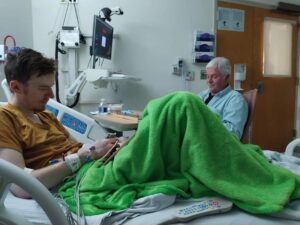If you or someone you love needs a kidney transplant, the Find a Kidney website offers a wide range of resources and support to help you search for a living donor. Register now and take the first step toward finding a match.
My Child’s Kidney Transplant Story: Greer Viau
In 2021, at his annual physical, our then-23-year-old son’s lab work came back with too much protein in his urine. He was referred to a nephrologist and had a biopsy. We were shocked to learn he had Stage 3 chronic kidney disease, with a GFR (glomerular filtration rate, a measure of kidney function) of 58.

Greer felt fine and had no symptoms. He was eventually diagnosed with collapsing FSGS (focal segmental glomerulosclerosis), and they had no idea how he got it. They thought it was most likely a virus that settled in his kidneys, perhaps undiagnosed COVID, strep, mono, or Epstein–Barr. They decided to put him on meds and monitor him. Life went on, and he continued feeling fine.
In January 2023, his company abruptly closed, so I urged him to get a physical while still insured. He said he was fine and would be seeing the nephrologist in March. I said no, get a physical now. He did and was told to see his nephrologist right away. He called me crying, saying his GFR was plummeting and he needed a transplant.
On February 22, he called to say he was really sick. His girlfriend rushed him to Brigham and Women’s Hospital in Boston with vomiting and swollen legs, and he was admitted. They discovered his GFR was down to 17. He was released on February 27, 2023—my 63rd birthday. At home, he just stared into space, asking, “Who is going to give me an organ out of their body to save my life?”

My heart sank. I could only say, someone WILL. We learned that the wait for a kidney from a deceased donor could be seven to 10 years, and it was up to us to do outreach for a living donor.
We were told Brigham was affiliated with the National Kidney Registry and participated in the Microsite Program, which meant Greer could get a personalized donor search microsite. I wrote his microsite page and added photos, submitted it for approval, and it was immediately made live so we could start the outreach.
My husband was out as a potential donor due to Type 2 diabetes. Our younger son was eliminated because of their genetic connection and not really knowing why our older son was sick to begin with. I began my testing immediately but was devastated to be disqualified two months into my testing with a GFR of 85. I begged them to consider me, but the hospital would only look at a GFR of 90 or above.
We used flyers, social media, joined more than a dozen city and town pages and groups in our area and our hometowns, and had family and friends share with everyone they knew—we were relentless.
Donna Viau
My husband designed and had 150 magnetic bumper stickers made with a QR code link to Greer’s microsite. We were featured in our local paper, on the city website, local Boston news, radio, theater programs, and in publications and on websites connected to our friends and families. We used flyers, social media, joined more than a dozen city and town pages and groups in our area and our hometowns, and had family and friends share with everyone they knew—we were relentless.
We were told NEVER to discuss blood type. If you disclose the blood type of the person who needs a transplant, people might think, oh, I don’t match, and not come forward. This can prevent the possibility of a paired exchange or voucher donation, which has the potential to save multiple lives—including the person you’re trying to help. We were also advised to tell anyone with medical questions that if they came forward to be tested, all their questions would be answered by the transplant coordinator.
In March, Greer had to go on emergency hemodialysis. He had to go every other day. The clinic was a dreary place, but the nurses were wonderful. I kept him company at his treatments, and I can’t tell you how hard it is to see your child hooked up to a machine for hours and see his blood being pumped through tubes.
Greer was amazing. He never, ever complained. He was also training on home peritoneal dialysis and switched to that on Easter of 2023. It was difficult, as it is usually supposed to be for eight hours a night while sleeping, but he had to be on it 13 hours every night.

He couldn’t work. I made him special foods for his no-sodium, low-potassium diet. He lost weight, and we had many emergency room visits. We masked constantly and kept our contact with crowds to a minimum. His life was in total upheaval. It was awful.
His microsite got over 4,350 views, and 65 people came forward for medical evaluation. In August 2023, he was notified that he had an altruistic anonymous living donor. We were told not to share anything yet, as the team doesn’t consider a patient officially transplanted until the surgery is complete—unexpected issues can arise even moments before the operation.
He had his transplant at Brigham on September 14, 2023. We were told the donor was doing well and had given Greer a perfect match. Greer was in the hospital for six days and was like a new person. He now had a post-transplant team. We had to go in two to three times per week for labs/check-ups and medication adjustments. He needed rest and light walking, and someone would have to be with him at all times for at least the first three to four weeks. He had to monitor his weight, urine output, temperature, and blood pressure.
By the first week of November, he could go back to his apartment (he had been living with us so I could look after him), and drive, but he could not go to restaurants, large indoor venues, buses, planes, or trains for six months. He was allowed light exercise, mainly for circulation, and no lifting.
As the months passed, his appointments became less frequent, but still regular. His meds are for life. He can’t have raw sushi, marijuana (due to the potential for bacteria and fungus), grapefruit, or ibuprofen, has to avoid deli meats and salad bars, and limit alcohol. Most of those things were easy to give up because they were never part of his lifestyle, except he loved sushi.

We had all written the donor and sent letters through the transplant office right after the transplant. A week after Greer returned to his apartment, I had a heart attack. The doctors thought it was due to stress. I’ve recovered well and continue to be monitored with medication and regular checkups. After I got home from the hospital and the entire family was together, we got a letter from his donor. It was amazing. She was a wife and mother who had seen one of my posts on social media through a mutual friend and felt what she called a “heart tug” to come forward. She had been standing right beside us in the hospital when she and Greer were both called for pre-op. She recognized us from Facebook but said nothing.
We called her and thanked her. We started talking, texting, writing, sending her Christmas and birthday gifts, etc. She came to our home in May 2024 to meet in person. Greer baked her scones and cookies. He was nervous to meet her. He said, Mom, what do I say to her? She saved my life. I said, just say thank you, she’s a mother, she knows. It was an incredible day, and she is part of our family forever.
Greer now lives a healthy lifestyle, quietly appreciating the lifesaving gift he received. He is back to some of the things he used to do, like snowboarding, indoor rock climbing, playing ping pong, and cooking. He is moving forward with life and LIVING IT. Thank you to everyone who comes forward for evaluation, for helping save the lives of people in need through living kidney donation.

